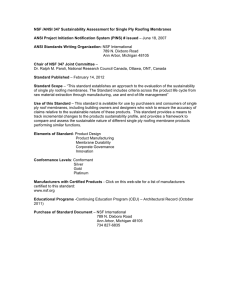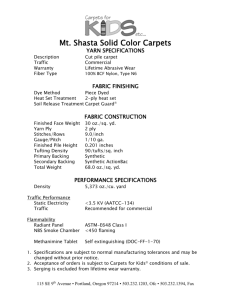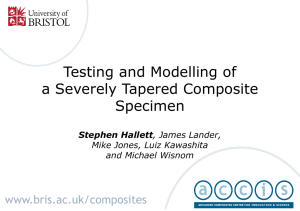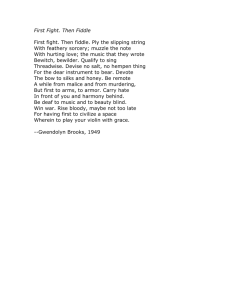The Mechanical Performance of Laminated Structures -- A
advertisement
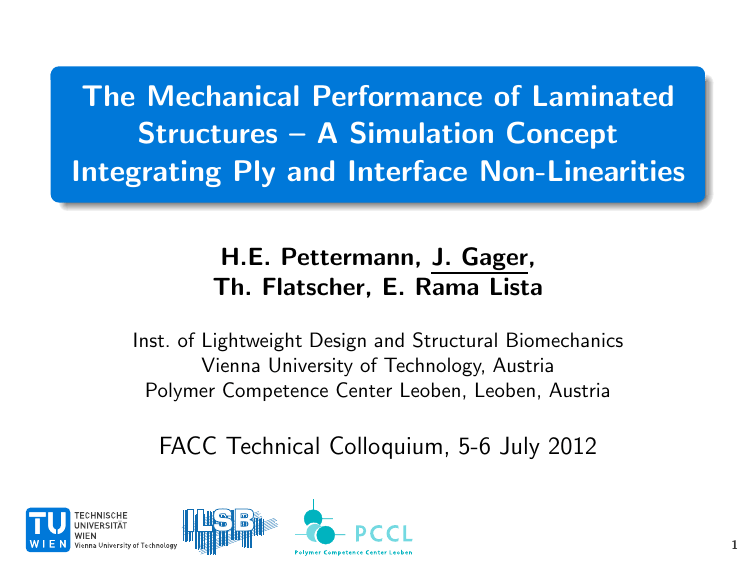
The Mechanical Performance of Laminated Structures – A Simulation Concept Integrating Ply and Interface Non-Linearities H.E. Pettermann, J. Gager, Th. Flatscher, E. Rama Lista Inst. of Lightweight Design and Structural Biomechanics Vienna University of Technology, Austria Polymer Competence Center Leoben, Leoben, Austria FACC Technical Colloquium, 5-6 July 2012 1 Selected references Th. Flatscher and H.E. Pettermann. A constitutive model for fiber-reinforced polymer plies accounting for plasticity and brittle damage including softening - implementation for implicit FEM. Composite Structures, 93(9):2241–2249, 2011. Th. Flatscher, C. Schuecker, and H.E. Pettermann. Prediction of plastic strain accumulation in continuous fiber reinforced laminates by a constitutive ply model. International Journal of Fracture, 158:145–156, 2009. Th. Flatscher, M. Wolfahrt, G. Pinter, and H.E. Pettermann. Simulations and experiments of open hole tension tests — assessment of intra-ply plasticity, damage, and localization. Composites Science and Technology, 72(10):1090–1095, 2012. J. Gager and H.E. Pettermann. Numerical homogenization of textile composites based on shell element discretization. Composites Science and Technology, 72(7):806 – 812, 2012. C. Schuecker and H.E. Pettermann. Constitutive ply damage modeling, FEM implementation, and analyses of laminated structures. Computers & Structures, 86(9):908–918, 2008. G. Wimmer, W. Kitzmüller, G. Pinter, T. Wettemann, and H.E. Pettermann. Computational and experimental investigation of delamination in l-shaped laminated composite components. Engineering Fracture Mechanics, 76(18):2810 – 2820, 2009. Outline 1 Aims & Scope 2 Approach shell modeling concept non-linear ply behavior interface modeling 3 Applications open hole tension test braidings/weaves 3 point bending L-flange 4 Conclusion 3 Outline 1 Aims & Scope 2 Approach shell modeling concept non-linear ply behavior interface modeling 3 Applications open hole tension test braidings/weaves 3 point bending L-flange 4 Conclusion 4 Aim Aim predict non-linear behavior of laminated structures • beyond elastic limit • peak load predictions • failure modes • progression of damage in plies and interfaces ply damage induced delamination delamination induced ply damage [Schuecker, PhD-Thesis] 5 Aim Computational efficiency in terms of • computation time • hardware requirements academic state-of-the-art aspired 6 Outline 1 Aims & Scope 2 Approach shell modeling concept non-linear ply behavior interface modeling 3 Applications open hole tension test braidings/weaves 3 point bending L-flange 4 Conclusion 7 Length Scales hierarchical length scales of laminated FRP 8 Shell Modelling Concept Common approach – layered shell 9 Shell Modelling Concept Multiple shell approach FEM model of a composite structure constitutive model for "smeared out" ply material multiple shell elements with interfaces degradable interfaces 10 Ply Behavior ply material behavior — brittle vs. ductile → ductile behavior — accumulation of residual strains → brittle behavior — stiffness degradation (but hardening) → brittle behavior — softening (localization) 11 Ply Behavior • plasticity model • distributed damage model • localized damage model [Flatscher/Schuecker/Pettermann 2009] 12 Ply Behavior • plasticity model • distributed damage model • localized damage model [Schuecker/Pettermann 2008] 12 Ply Behavior • plasticity model • distributed damage model • localized damage model [Flatscher/Pettermann 2011] 12 Ply Behavior advantage of the model • anisotropic damage • modeled mechanisms determine the response • interpretable parameters • no introduction of sites where failure is expected FE-software model (Abaqus) • anisotropic localized damage • numerically efficient • no plasticity • no distributed damage 13 Interface modeling Interface modeling cohesive contact / cohesive elements • degradable interface properties • no existing cracks necessary • readily available 14 Outline 1 Aims & Scope 2 Approach shell modeling concept non-linear ply behavior interface modeling 3 Applications open hole tension test braidings/weaves 3 point bending L-flange 4 Conclusion 15 OHT — Experiments vs. Simulations fiber reinforced epoxy UD [(+45/− 45)4 ]S focus on ply non-linearities no inter-ply delamination X-SYMM curing stresses are taken into account Y-SYMM 16 Experimental Setup at PCCL [Flatscher, et.al 2012] MTS, ARAMIS specimen production at FACC AG 17 OHT — Experiments vs. Simulations [(+45/− 45)4 ]S — longitudinal strains εxx ; same scaling Experiment: F = 10.6 kN (top) Simulation: F = 9.8 kN (bottom) 18 OHT — Experiments vs. Simulations [(+45/− 45)4 ]S — localization 19 Braidings / Weaves hierarchical length scales of textile laminates macro (structure) meso 2 (lamina) meso 1 (textile ply) micro (fiber) 20 Braidings / Weaves Uniaxial tensile loading 21 Braidings / Weaves Multilayer Laminates 22 3 Point Bending 0/90 two layer laminate each layer – shell elements cohesive zone for delamination u 0 90 5 depth: 0.03 2x 0.175 CZ U 23 3 Point Bending damaged transverse Young’s modulus E2 damage induced delamination L-Flange lay-up [0/90/0/90/0]S based on PhD thesis G.Wimmer → focus on delamination Experiments at PCCL, samples by FACC AG [Wimmer,2008] 25 L-Flange ply damage relevant stress state at the delamination front (not yet critical) L-Flange progressive delamination ⇒ ply stresses reach critical value delamination jumps to next interface delamination induced ply damage L-Flange [Wimmer,2009] 28 Outline 1 Aims & Scope 2 Approach shell modeling concept non-linear ply behavior interface modeling 3 Applications open hole tension test braidings/weaves 3 point bending L-flange 4 Conclusion 29 Conclusion simulation of laminated structures based on. . . • anisotropic ply damage — including softening • ply plasticity • delamination ply damage – delamination interaction ... tools for highly non-linear structural analyses 30 The Mechanical Performance of Laminated Structures – A Simulation Concept Integrating Ply and Interface Non-Linearities H.E. Pettermann, J. Gager, Th. Flatscher, E. Rama Lista Inst. of Lightweight Design and Structural Biomechanics Vienna University of Technology, Austria Polymer Competence Center Leoben, Leoben, Austria FACC Technical Colloquium, 5-6 July 2012 31

